How Russia's 35-mile armoured convoy ended in failure
- Published

Three days into Russia's invasion of Ukraine, a huge 10-mile (15.5km) line of armoured vehicles was spotted by a satellite in the north of the country. The very same morning in Bucha, just outside Kyiv, 67-year-old Volodymyr Scherbynyn was standing outside his local supermarket when more than a hundred Russian military vehicles rolled into town. Both Volodymyr and the satellite were witnesses to a key part of President Vladimir Putin's plan for a quick and overwhelming victory. They were also witnesses to its failure.
The western media called it a convoy. In reality, it was a traffic jam and a major tactical blunder. Forty-eight hours after that first satellite photograph, on 28 February 2022, the line of vehicles had grown to a colossal 35 miles (56 km) long. The vehicles were stalled for weeks. Then finally they retreated, and seemingly disappeared overnight.
What happened? Why did such a massive force fail to reach Kyiv?
A BBC team spoke to dozens of witnesses; including military personnel, national and international intelligence services, civilians, veterans, and the territorial defence, all of whom came into contact with the convoy. It also gained access to Russian maps and documents that shed light on what the plan actually was, and why it went so spectacularly wrong.
Satellite images of the convoy captured last year © 2022 Maxar Technologies
The first hours
The story starts on the first day of the war, in the north of Ukraine at its border with Belarus.
Stepping outside for his first cigarette of the day, 23-year-old Vladyslav from Ukraine's 80th Air Assault Brigade saw a flurry of bright lights in the night sky.
"I remember watching the lights emerge from the whole forest. At first I thought they were car headlights. But then I realised they were Grads [self-propelled multiple missile launchers]. They were firing at us."
Camped deep within the forest of the Chernobyl exclusion zone, Vladyslav's unit was on patrol when the first Russian vehicles crossed into Ukraine.
"The whole earth was shaking. Have you ever been in a tank? There's no other sound like it. It's a powerful thing."
As planned in the event of any attack, Vladyslav and the rest of the 80th brigade blew up the bridge connecting Chernobyl to the next big town, Ivankiv.
The Russians would be forced to waste time building a replacement pontoon bridge, giving Vladyslav and his unit time to pull back to Kyiv.
"At first I was surprised, why didn't we stop them there in Chernobyl? But we needed to learn about our enemy. So that's what we did."
This close to the Belarus border, the Ukrainians could not afford to open fire and risk starting another conflict. Their priority was to first understand Russia's battle plan, before sending their troops into the line of fire.
Putin's master plan
What Vladyslav saw were the first vehicles of what would become the convoy.
Contrary to many media reports at the time, the 35 mile-long (56 km) column was in fact 10 separate Russian tactical battalion units, according to the Ukrainian Armed Forces.
The Russian army also attacked Ukraine in the east and south, but the mission for these 10 units was specific - enter Ukraine from Belarus, overthrow Ukraine's capital city and remove the government. In military terms: a decapitation attack.
One Russian document, seen by the BBC, shows a timetable for the plan. After the first battalion crossed into Ukraine at 04:00 am on 24 February, their orders were to advance straight to Kyiv arriving by 14:55.
Several of the battalions were to advance to Hostomel, just north of Kyiv, to back up the troops who'd been airlifted in to secure the airport.
The rest were to head straight into the centre of Kyiv.
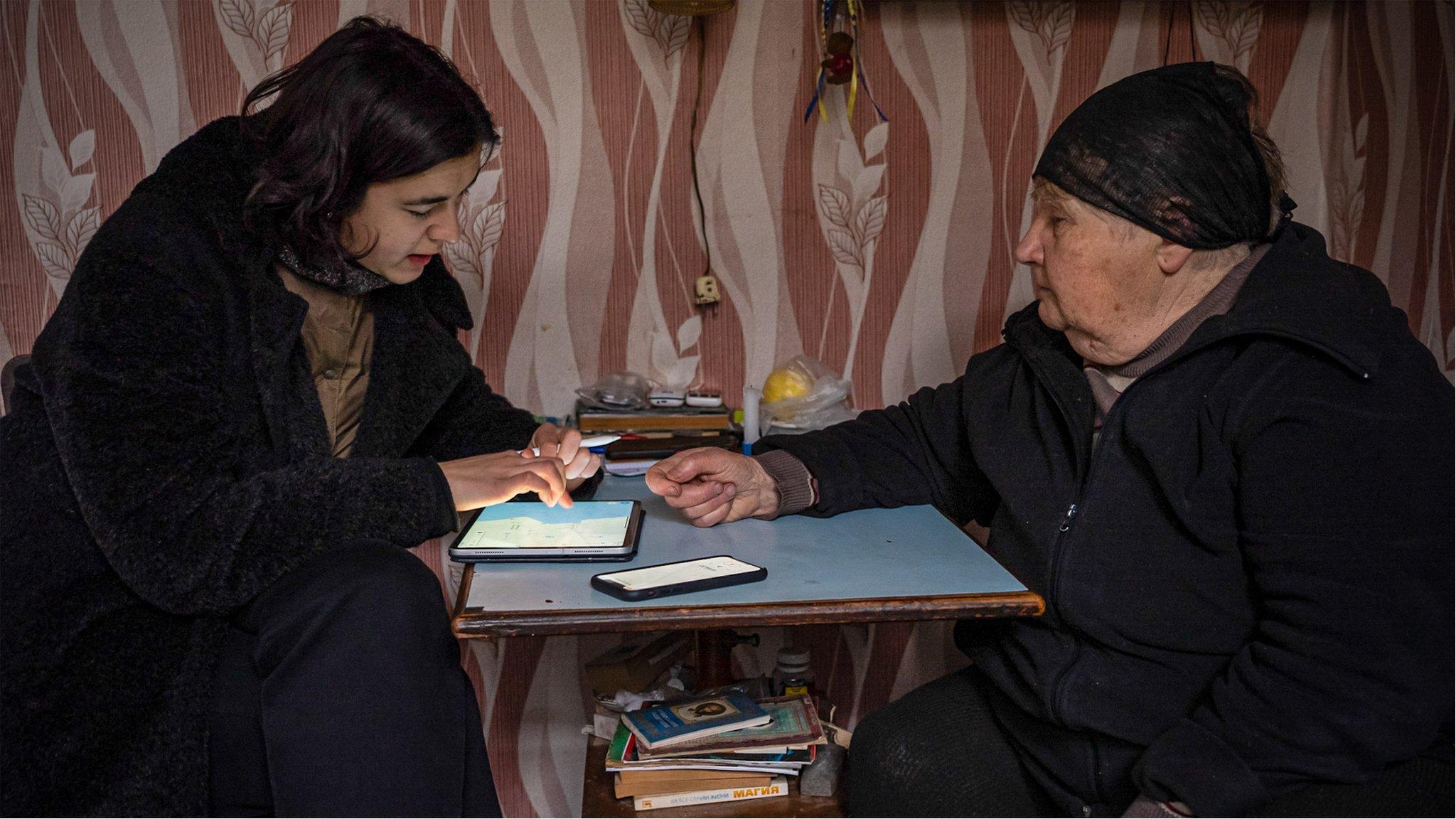
Luibov Demydiv (R), a pensioner from Demydiv, points on the map to where she saw the convoy circling after a bridge was destroyed, stopping their advance
The assault heavily relied on two elements - secrecy and speed.
According to the Royal United Services Institute (RUSI), external (a UK-based security think tank) by keeping plans about an attack on the capital under wraps, Russian soldiers could outnumber the Ukrainian forces by 12 to one in the north of Kyiv.
However, Putin's secrecy came at a cost. So successful was his deception, even most of his commanders did not receive their orders until 24 hours before the invasion.
On a tactical level, this left them vulnerable. They lacked food, fuel and maps. They were without proper communication tools. They had insufficient ammunition. They were even ill-prepared for the winter weather.
Kitted out with the wrong tyres and surrounded by snow, the Russians drove straight into a mud bath. Civilians close to Ivankiv describe Russian soldiers telling Ukrainian farmers to help pull their tanks out of the sludge.
Unable to progress, the Russian vehicles needed to divert to paved roads in order to avoid soft ground, forcing thousands to group into a single column.
But with limited communication between the battalions, they almost immediately converged into one almighty traffic jam.
As one military expert on the ground put it: "You don't ever travel into hostile territory in a long convoy. Ever."
Based on witness testimony and intelligence from the Ukrainian military, we were able to map the ground the convoy covered in the time between the outbreak of war and the end of March. By avoiding travelling across fields, vehicles ended up on most of the main roads north of Kyiv.

By the time the column had grown as long as 35 miles (56 km) it included up to 1,000 tanks, 2,400 mechanised infantry vehicles and 10,000 personnel, as well as dozens of supply trucks carrying food, fuel, oil and ammunition.
Stalled north of Kyiv and running out of food and fuel, the Russians had also underestimated their adversary.
A united resistance
For three days Volodymyr Scherbynyn and his fellow volunteers, the majority of them pensioners, had been preparing for the arrival of the convoy in their hometown of Bucha.
Armed with one machine gun between the 12 of them, they took down all the road signs, built checkpoints, and prepared hundreds of petrol bombs.
Until finally, on Sunday morning the Russian tanks rolled into town.
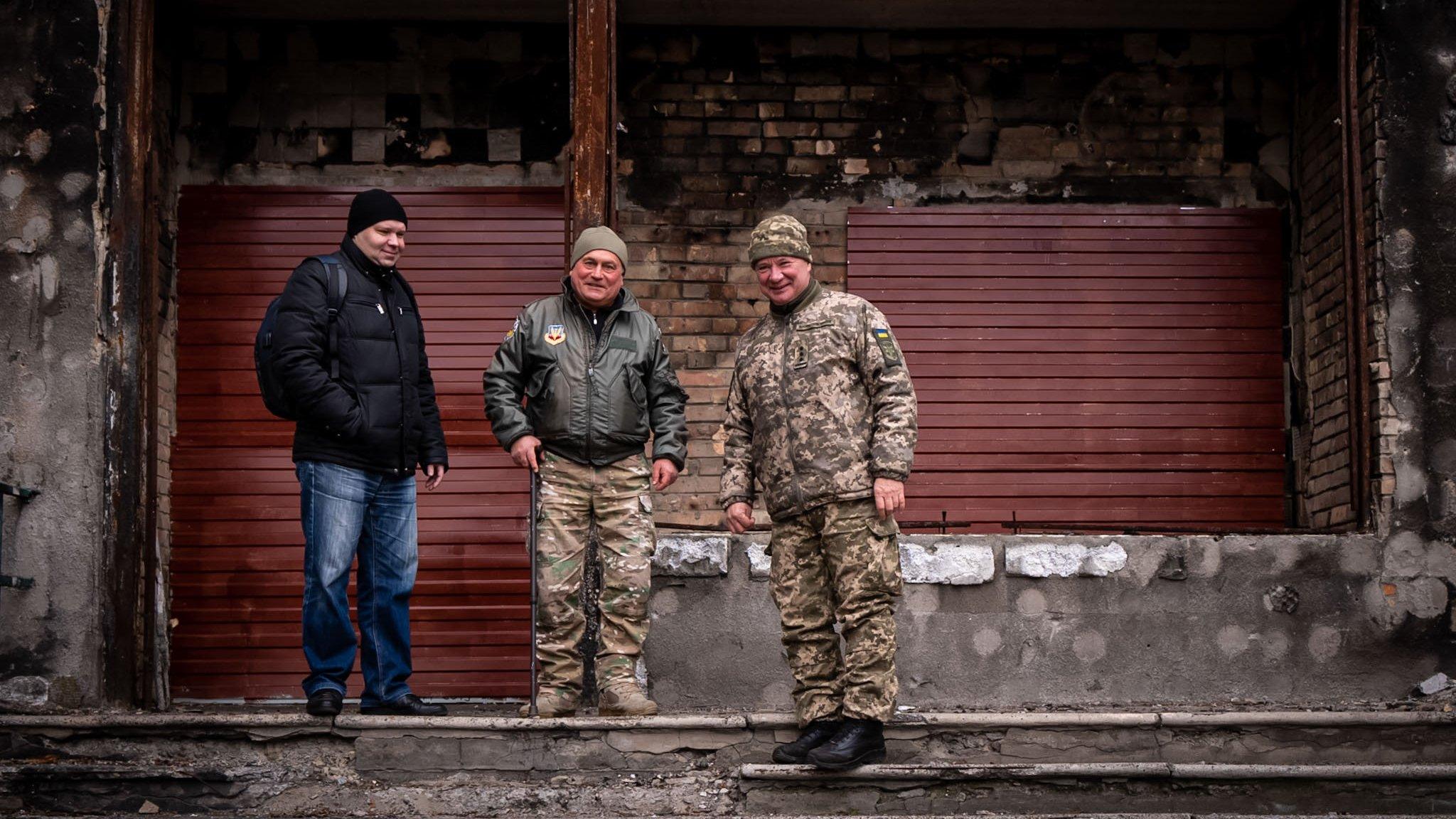
Maksym (L) Volodymyr (C) and '"the colonel" (R) stand in front of their bombed out office for local volunteers
For nearly 30 minutes, Volodymyr and his grassroots unit battered the tanks with what little they had.
"We set two of the vehicles on fire and slowed down the whole convoy," says Volodymyr.
But then came the retaliation.
"When they saw us throwing bottles they opened fire," says 30-year-old Maksym Shkoropar. "I was a barman. I didn't have any military training."
By the end of that half hour, every one of Volodymyr's party had been shot and evacuated to hospital.
But even from the sick bay, Volodymyr kept on fighting - receiving and cross-checking sightings of the convoy from civilians all over the Kyiv region and calling them in to the Ukrainian authorities.
On the other end of the line was 23-year-old local city councillor for Irpin, Roman Pohorily.
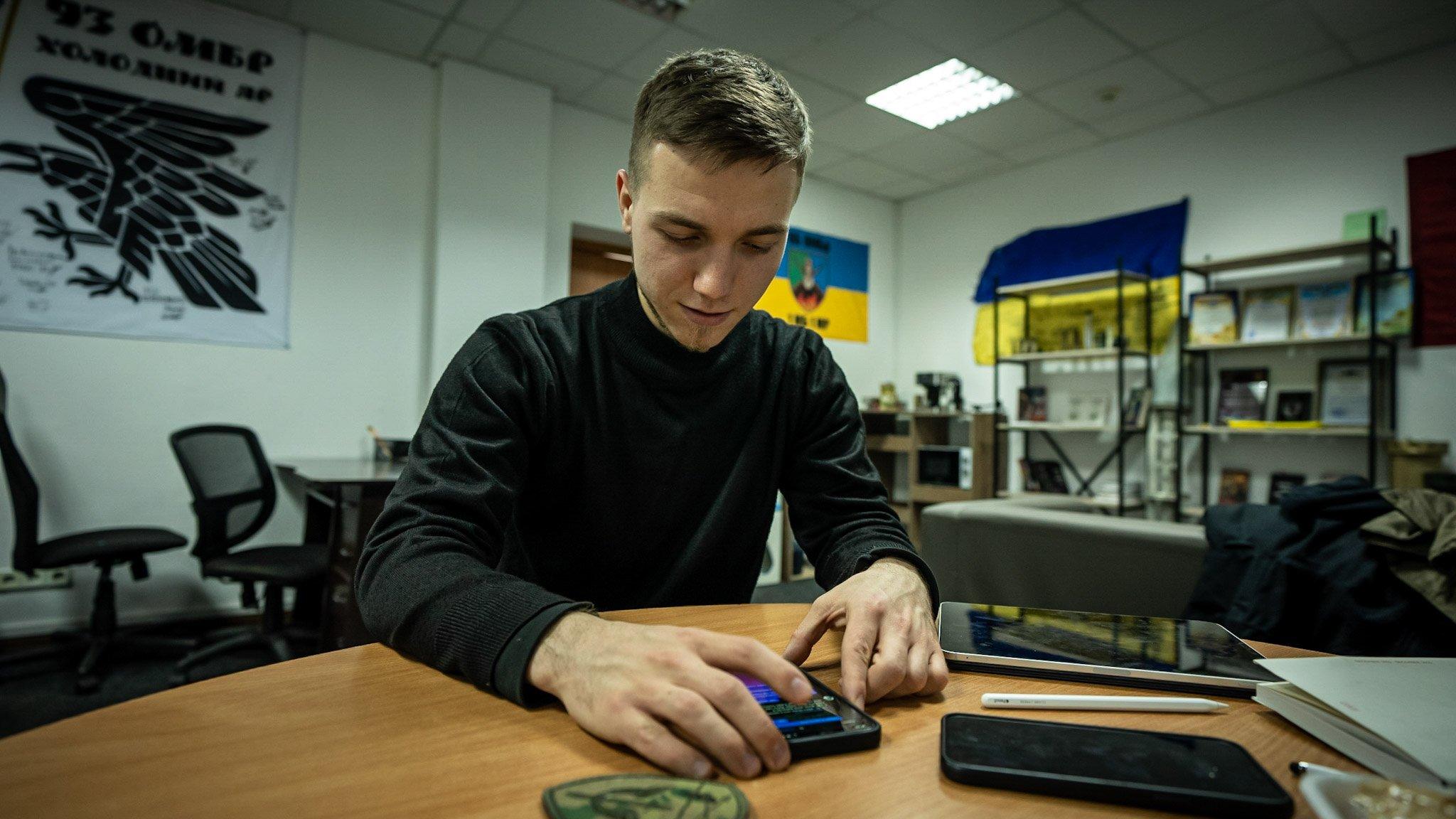
Lawyer and councillor by day, Roman searches for Russian posts on social media by night.
He tells the BBC he didn't sleep for three days.
"My colleague and I were manning the hotline at the council office, taking calls about the column, as well as saboteurs - people who were painting marks on the ground for the convoy to follow."
A councillor by day, Roman is also an open source intelligence expert by night. Co-founder of the highly regarded website DeepState, external, he pools together social media and intelligence reports. He geolocates them, then reposts them on his website.
"On their way to Kyiv, the Russians were posting videos on social media. We reposted the videos to expose their movements. They were just showing off, but in doing so, they got busted."
Most important during the assault on Kyiv, says Roman, was the sense of a united Ukraine.

Ukrainian volunteers distributing food
"Everyone was doing something. I admit it was very hectic in those first few days. But there were veterans helping civilians. Everyone wanted to defend their city."
In towns and villages all across the region, hundreds of attacks took place against the convoy, from civilians armed with homemade weapons to mechanised infantry and artillery.
Outdated tactics
In stark contrast to the Ukrainians, the Russian forces repeatedly exposed their inability to make dynamic decisions on the ground.
"The Russians were all carrying large metal boxes marked 'secret'," says Vladyslav from the 80th Brigade. "We seized one during an ambush. We found their maps marked with their entire route. After that we knew their whole strategy."
Their navigation tools were also woefully out of date. In the year since the invasion, the BBC has continued to find maps left behind by Russian troops that date back to the 1960s and 70s. Whole towns exist now that were not on the maps that they were using to navigate. We also found semaphore flags, a vastly outdated way to communicate between units.
One successful tactic by the Ukrainian resistance was to blow up bridges and dams ahead of the convoy, thus forcing the Russians to reroute. Reliant on old maps and with limited communications back to their high command, the Russian units frequently became paralysed by indecision.
Several satellite images show the Russian vehicles literally driving round and around in circles.
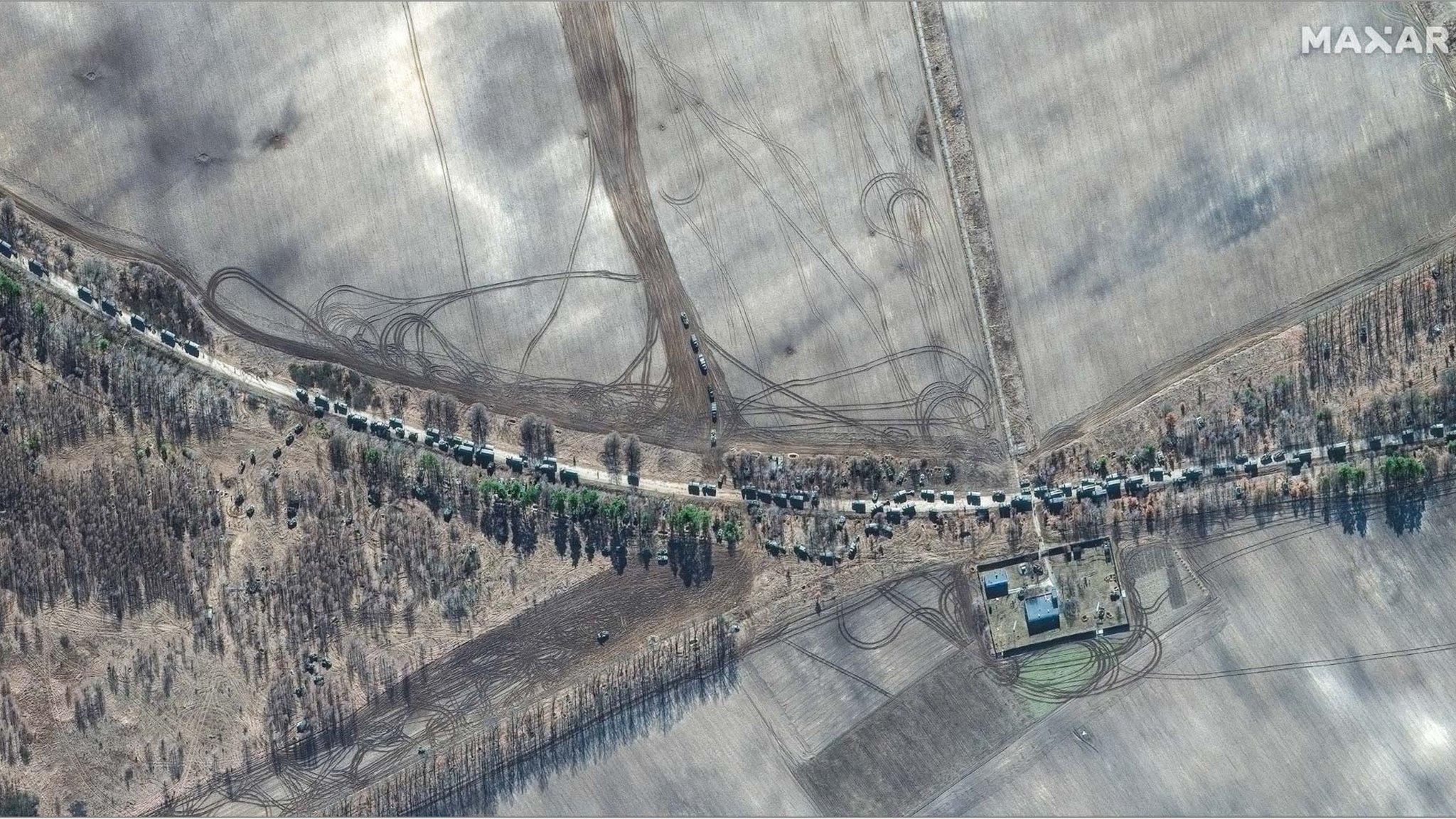
Occupation
Under pressure from Ukrainian air strikes and artillery, the Russian convoy was finally brought to a standstill just outside of Kyiv's city boundary. For thousands of civilians living close to the stalled troops, the experience was horrendous.
"They robbed everything from everywhere. They emptied the shops," says Vladyslav. "They also used civilians as human shields."
What happened in many villages and towns to the north and west of Kyiv is still being investigated by numerous authorities, including the International Criminal Court.
After four long weeks the Russians finally started to withdraw.
Two of the largest remaining battalions were defeated close to Hostomel airport. Another 370 tented army trucks, seemingly abandoned in Zdvizhivka village, were destroyed by artillery.
The Ukrainian military kept on pushing them back until 19 March, after which the Russians began to retreat from Kyiv Oblast.
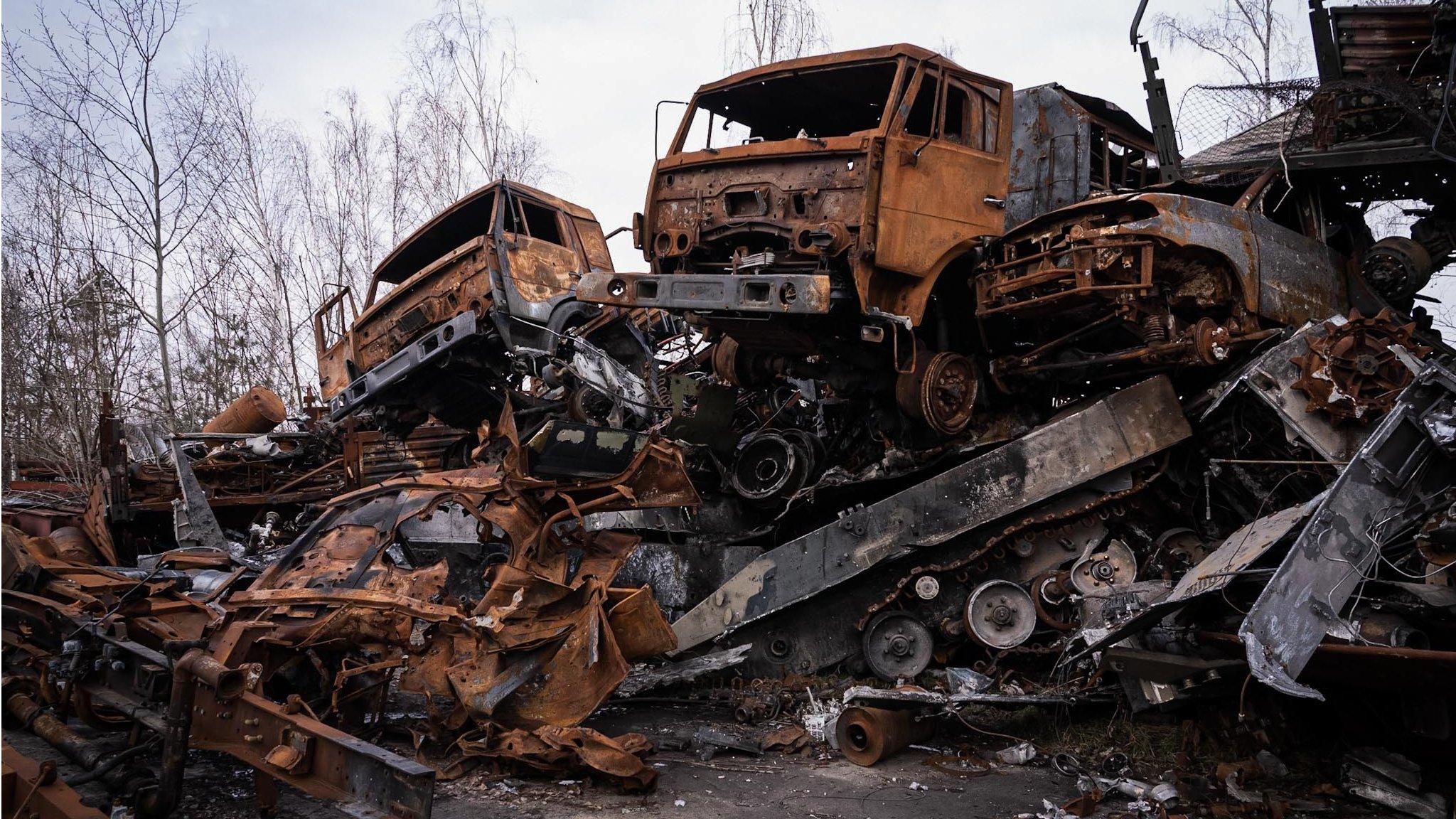
A graveyard of Russian vehicles from the convoy piled high in Hostomel
Russia is continuing to push into the eastern industrial heartland of Donbas, and strike in the south, in the direction of the Kherson and Zaporizhzhia regions.
Despite the speculation of a renewed attack on Kyiv, the majority of experts agree it would be unlikely as we have not seen a large-scale deployment of Russian troops to the Belarus border.
But still watching via reconnaissance drones close to the border, are the Ukrainian recruits.
"I'll always remember that night in Chernobyl," says Vladyslav. "When I went out to smoke with my friend. But by the time I'd finished my cigarette the war had started.
"My friend and I have this dream, that we will go on shift, just like we did that day, and as we smoke another cigarette we will hear that the war has ended. And that we won."
Special thanks to Slava Shramovych, Marcus Buckley, Michael Whelan, Alastair Thompson, Ben Allen and Tim Coey.